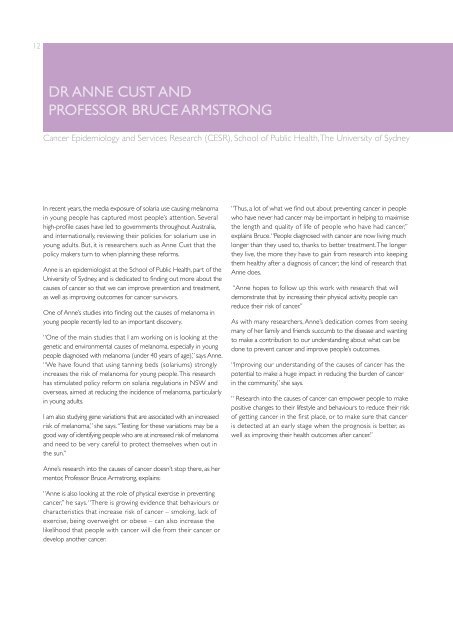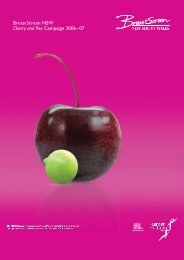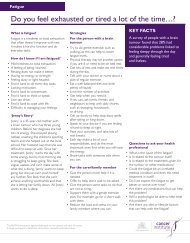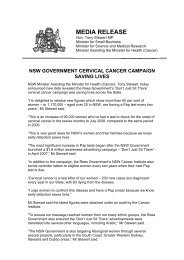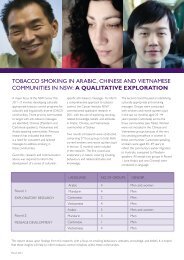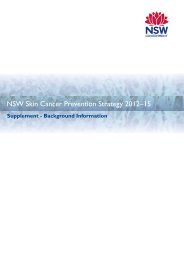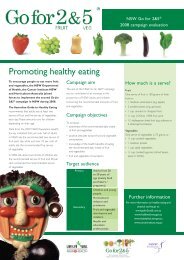NSW Research Achievements Report 2011 - Cancer Institute NSW
NSW Research Achievements Report 2011 - Cancer Institute NSW
NSW Research Achievements Report 2011 - Cancer Institute NSW
Create successful ePaper yourself
Turn your PDF publications into a flip-book with our unique Google optimized e-Paper software.
12Dr Anne Cust andProfessor Bruce Armstrong<strong>Cancer</strong> Epidemiology and Services <strong>Research</strong> (CESR), School of Public Health, The University of SydneyIn recent years, the media exposure of solaria use causing melanomain young people has captured most people’s attention. Severalhigh-profile cases have led to governments throughout Australia,and internationally, reviewing their policies for solarium use inyoung adults. But, it is researchers such as Anne Cust that thepolicy makers turn to when planning these reforms.Anne is an epidemiologist at the School of Public Health, part of theUniversity of Sydney, and is dedicated to finding out more about thecauses of cancer so that we can improve prevention and treatment,as well as improving outcomes for cancer survivors.One of Anne’s studies into finding out the causes of melanoma inyoung people recently led to an important discovery.“One of the main studies that I am working on is looking at thegenetic and environmental causes of melanoma, especially in youngpeople diagnosed with melanoma (under 40 years of age),” says Anne.“We have found that using tanning beds (solariums) stronglyincreases the risk of melanoma for young people. This researchhas stimulated policy reform on solaria regulations in <strong>NSW</strong> andoverseas, aimed at reducing the incidence of melanoma, particularlyin young adults.I am also studying gene variations that are associated with an increasedrisk of melanoma,” she says. “Testing for these variations may be agood way of identifying people who are at increased risk of melanomaand need to be very careful to protect themselves when out inthe sun.”“Thus, a lot of what we find out about preventing cancer in peoplewho have never had cancer may be important in helping to maximisethe length and quality of life of people who have had cancer,”explains Bruce. “People diagnosed with cancer are now living muchlonger than they used to, thanks to better treatment. The longerthey live, the more they have to gain from research into keepingthem healthy after a diagnosis of cancer; the kind of research thatAnne does.“Anne hopes to follow up this work with research that willdemonstrate that by increasing their physical activity, people canreduce their risk of cancer.”As with many researchers, Anne’s dedication comes from seeingmany of her family and friends succumb to the disease and wantingto make a contribution to our understanding about what can bedone to prevent cancer and improve people’s outcomes.“Improving our understanding of the causes of cancer has thepotential to make a huge impact in reducing the burden of cancerin the community,” she says.“ <strong>Research</strong> into the causes of cancer can empower people to makepositive changes to their lifestyle and behaviours to reduce their riskof getting cancer in the first place, or to make sure that canceris detected at an early stage when the prognosis is better, aswell as improving their health outcomes after cancer.”Anne’s research into the causes of cancer doesn’t stop there, as hermentor, Professor Bruce Armstrong, explains:“Anne is also looking at the role of physical exercise in preventingcancer,” he says. “There is growing evidence that behaviours orcharacteristics that increase risk of cancer – smoking, lack ofexercise, being overweight or obese – can also increase thelikelihood that people with cancer will die from their cancer ordevelop another cancer.


